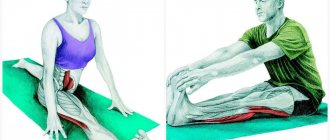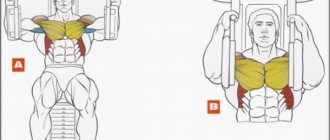Vacuum is one of the most effective exercises for strengthening the abdominal muscles. It arose from the ancient practices of yoga, and gained its popularity during the “golden era of bodybuilding.”
The calling card of athletes of that time was the so-called V-shaped figure: developed shoulders, a wide chest and, of course, a flat, sculpted stomach and a narrow waist. Bodybuilding legend Arnold Schwarzenegger admitted that such an aesthetic combination is achieved largely through the “abdominal vacuum” exercise.
To understand why to do a vacuum, how to do it and how the effect of its implementation occurs, let us turn in the article to the structure of the abdominal muscles.
Anatomy of the abdominal muscles
The abdominal press consists of external and internal muscle groups:
- External abdominal muscles: Rectus.
- External oblique.
- Internal oblique.
The deepest layer is formed by the transverse abdominal muscles, which encircle the waist and act as a natural corset.
That is, it is this muscle group that is responsible for supporting the internal organs and a flat stomach. The absence of loads on the transverse muscle group contributes to:
- The appearance of excess weight at the waist, since the fibers of these muscles are of the slow type, using subcutaneous fat as an energy source.
- Lack of strength in the muscle corset, which leads to the internal organs squeezing the abdomen forward.
Classic exercises for training the abs (lifting the body, legs, twisting, etc.) mainly work only the external muscle groups that form the relief.
To effectively strengthen the transverse muscles, it is necessary to do static (isometric) exercises. Along with the plank, the best example of a static exercise for developing the internal abdominal muscles is the vacuum .
Common questions on the topic
Very often, nutritionists and fitness trainers receive questions from those who want to lose weight quickly and beautifully. The answers to the most common ones can be found below.
How to get rid of beer belly in a week?
The so-called beer belly is a serious problem that is caused by regular overeating, a sedentary lifestyle, and possibly hormonal changes caused by estrogen-like substances contained in hops.
Abdominal obesity in men cannot be associated solely with beer - the direct effect of this drink on the volume of fat accumulation has not been scientifically proven, like the “hormonal version”.
Rather, the growth of the belly among beer drinkers is associated with the consumption of high-calorie snacks with beer, as well as with a sedentary lifestyle - if a person is used to drinking a liter or two of beer almost every day, he is unlikely to have the time and desire to exercise.
However, if a man decides to quickly get rid of his beer belly, he will be able to do it easier and faster than a woman - all the same hormones, only male ones, contribute to high training efficiency and rapid loss of fat mass. The main thing is to abstain from beer. Otherwise, it will be enough to follow these recommendations.
How to quickly get rid of belly fat for a teenager?
This question is usually asked by girls 12-14 years old. Unfortunately, modern beauty standards, which are far from reality, force teenagers to react painfully to natural body changes during puberty. The fact that a small layer of fat on the thighs and abdomen is natural for the female body is of little consolation to them. If there really is a problem, first of all, you need to normalize your diet by removing “food waste” from it, and also go in for sports, at least with the exercises given in the article.
Under no circumstances should a teenager go on extreme diets, carry out any cleansing procedures, anti-cellulite massages, etc. on their own.
During a period when a child’s body not only grows very quickly, but also changes, acquiring new functions, any inadequate load or lack of nutrition can have the most deplorable effect. And vice versa - any correct effort is incredibly effective, since a young, strong and rapidly growing organism is able to quickly transform and develop.
How to get rid of belly fat after childbirth in a week?
Naturally, it is important to take care of your belly, because reducing it to normal size is not only a matter of beauty, but also of health. But setting yourself such a narrow time frame is unreasonable.
After childbirth, the uterus shrinks to its normal size within three days, but the muscles of the abdominal wall and skin do not immediately regain their original tone. The postpartum recovery time depends on many factors: the woman’s age, her state of health, the woman’s behavior during pregnancy, the natural elasticity of the skin, etc.
To support the internal organs, speed up the restoration of the muscle corset and reduce stretched skin, they practice swaddling (swaddling) the abdomen - tightly swaddling it with a long towel. Today, special bandages, belts, and shapewear can be used for this purpose.
It is important that the shapewear is natural and not too tight. A light massage using oils is possible. No exercises, body wraps, hardware or cosmetic procedures, diets! All this can be connected a little later with the doctor’s permission.
As soon as a woman’s health has fully recovered after pregnancy and childbirth, she can begin an active fight against a sagging and/or enlarged belly. In this case, all the recommendations given in the article are suitable. Massages and wraps will have a good effect, especially if you have skin problems. It is important to coordinate any planned procedures with your doctor, especially if you are a nursing mother.
Our next article will tell you more about how to remove belly fat after childbirth.
How is it useful?
Systematic implementation of abdominal vacuum allows:
- get rid of a stretched and bulging belly;
- significantly reduce your waist size;
- strengthen the abdominal muscles;
- visually enlarge the chest;
- improve posture;
- stabilize the spine and reduce pain in the lower back;
- improve digestion and blood supply to the abdominal organs;
- strengthen the diaphragm muscles;
- reduce the visceral layer of fat that accumulates near the internal organs.
In addition, vacuum gymnastics classes do not require special equipment and are suitable for performing at home and in the office.
How many times to vacuum the abdomen?
Slow twitch fibers of the internal abdominal muscle groups are best developed during daily training and long-term static loads.
Therefore, to achieve the result it is necessary:
- Hold your breath and hold the contracted position for as long as possible (it is optimal to perform 3-5 sets of 1-2 minutes each).
- Do a “vacuum” as often as possible (preferably at least 5 times a week).
How is it done?
In order to do a stomach vacuum correctly, you need to understand its technique. Although at first glance it seems simple, this technique consists of many nuances, mainly related to the intricacies of proper breathing, and includes the following steps.
Namely:
- Position yourself in the starting position.
- Take a deep breath through your nose, trying to direct the air not so much into your lungs as down your stomach. The press should move forward.
- Exhale sharply through your mouth, trying to release all the air out. To do this, you can use the sound “Pha!”
- Hold your breath.
- As you exhale, pull your stomach in as much as possible towards the spine and up, under the ribs.
- Stay in the position as much as possible. To begin with, the duration of the isometric contraction can be 10-15 seconds.
- Gradually relaxing your abs, inhale slowly.
- In the starting position, inhale and exhale 2-3 times, then repeat the exercise the required number of times.
It is necessary to make a vacuum on an empty stomach or 3-4 hours after eating.
Depending on the initial position, the abdominal vacuum is divided into four types:
- lying down;
- on the knees;
- sitting;
- standing.
The technical component of the exercise in each position remains unchanged. The only difference is the complexity of its implementation.
Vacuum lying down
The supine vacuum is considered one of the easiest to perform and is suitable for any beginner. In this position, gravity itself helps to retract the abdominal muscles.
How to do:
- Sit on a flat surface.
- Straighten your arms along your body.
- Bend your knees or stretch your legs forward.
- Apply the vacuum using proper technique.
Vacuum on your knees
As soon as you have mastered the technique of the “vacuum” exercise and can easily do 3-5 approaches of 1-2 minutes in a lying position, you can begin to vacuum on your knees (“on all fours”).
This option is considered somewhat complicated, because in this case you need to create a vacuum against gravity.
How to do:
- Sit on your knees.
- Place your palms on the floor at shoulder level.
- Do not bend your elbows and make sure your back is straight: do not slouch or arch your lower back.
- Apply the vacuum using proper technique.
Vacuum sitting
Sitting vacuum is another complicated option that uses the stabilizer muscles responsible for maintaining the balanced position of the spine.
How to do:
- Sit on a chair or any flat surface.
- Place your hands on your knees.
- Do not lean against the back of the chair.
- Control the position of your back: it should remain straight.
- Apply the vacuum using proper technique.
If desired, you can complicate the task and increase the load in this position. To do this, you need to sit not on a chair, but on a surface that provides unstable support, for example, a fitball.
You can also do a vacuum in the abdomen while sitting on your knees (not to be confused with a vacuum “on all fours”, where the body is parallel to the floor):
- Get on your knees.
- Take a sitting position.
- Move your hips away from your heels by 20-25 cm.
- Make sure that the body is perpendicular to the floor.
- Apply the vacuum using proper technique.
Vacuum standing
As you progress, move on to the most difficult type - standing vacuum. This option will allow you to maximize the use of the internal abdominal muscles and back stabilizer muscles.
How to do:
- Stand straight with your feet shoulder-width apart and knees slightly bent.
- Straighten your arms along your body.
- Make sure your back remains straight and your shoulders down.
- Apply the vacuum using proper technique.
There are several more variations of performing a vacuum from a standing position:
- Simplified standing vacuum. The hands are placed on the knees, the body moves forward, resulting in additional support.
- Complicated standing vacuum. The hands are placed behind the head, which allows the upper abdominal muscles to be even more involved in the work.
Correct technique
The main feature of the “vacuum” for the abdomen is breathing. We can say that the entire technique of this exercise is concentrated in breathing, which can be performed in several variations of body position - lying, standing, sitting, on all fours. They differ only in the complexity of implementation, and the “vacuum” itself remains unchanged. For beginners, it is better to stick to the lying version, while advanced ones can do it standing.
Algorithm of actions:
- Take the selected starting position (lying, standing, sitting or on all fours).
- Inhale through your nose as deeply as possible.
- Exhale sharply through your mouth, trying to achieve the sound “groin” and empty all your lungs.
- Hold your breath and immediately pull in your stomach, “pressing” it to your lower back.
- Hold in this position (without breathing) for 15 seconds. However, at the initial stage, until the lungs are accustomed to such a breath-hold, you can tolerate less.
- Gently relax your abdominal muscles, slowly exhaling the remaining air in your lungs.
- Take several measured breaths and exhalations and repeat the exercise again.
Exercise Vacuum for a Flat Belly (RESULT IN 14 DAYS)
Efficiency
- The effectiveness of a vacuum for the abdomen directly depends on the regularity and intensity of training. Obviously, after a few sessions, your stomach will not become flat and your waist will not become thin.
- It is very important to do the vacuum daily or at least 5 times a week, and also to constantly improve and complicate this exercise.
- If initially you can hold your breath and contract the abdominal position for 10-15 seconds, then gradually try to increase this time by 1-2 seconds.
- When one isometric contraction when performing a vacuum from a lying position is 40-50 seconds, you can do a vacuum on your knees, then do a vacuum from a sitting position, and, in the end, the most difficult option - a standing vacuum. But this is not the limit, because you can master the “nauli” technique - vacuum using wave-like movements of the abdominal muscles.
The result of performing a vacuum will appear even earlier if you control the internal transverse muscles throughout the day. To do this, you don’t need to hold your breath or suck in your stomach, you just need to always keep your abs tense. After some time, this will become a habit and the key to a flat stomach and a wasp waist.
Impressive weight loss results before and after
With the help of abdominal vacuum exercises, you can achieve excellent results in a fairly short time. Many people testify that in just two weeks of regular training it is possible to significantly reduce inches at the waist and tighten the stomach.
But such brilliant success awaits those people who initially have only a small tummy, and not a serious “life preserver” at the waist.
It was with a slightly hanging belly that 25-year-old Irina began to perform this exercise (see photos Before and After). Despite her overall slimness, she still had a small belly. And there was no way she could defeat him.
“Slender people have no way to lose weight, but, trying to overcome my stomach, I started actively working out my abs, but in the end I got the opposite result. Instead of being slim, my waist only became wider, and my figure began to resemble that of a teenager. The abs may have been pumping up, but they weren’t visible because of that hated belly.
Overweight people also face this, their belly becomes even larger. The muscles increase in size and begin to protrude fat deposits. Then my coach recommended the “vacuum” exercise to me. He explained that this way I could strengthen the muscles of my lower abdomen and reduce my waist size.
This was exactly what I was missing. The advantage is that I didn’t have to go on a strict diet. I just followed a healthy diet and did this exercise regularly,” Irina said about how she came to the decision to try the “stomach vacuum.”
The girl started with the option of practicing in a lying position. At first, she managed to keep her stomach pulled in for only five seconds. Then she switched to the exercise in a standing position and began to gradually increase the time she spent in a static position.
Now the girl has already achieved that she can withstand up to ten seconds with her stomach retracted.
“My lower abs have strengthened and my muscles have tightened. Even when I completely relax my body, my stomach remains flat. Of course, it was not possible to pump up the cubes, because this exercise is not designed for such an effect. But the volume has gone from the waist.
Before I started training, my volume was 60 centimeters when I measured my waist in the morning on an empty stomach. And with the help of a vacuum for the abdomen, it was possible to reduce this number by four centimeters. And this despite the fact that I was not on a diet. The weight remained unchanged,” the girl shared her results.
In some cases, people encounter unexpected problems, which, however, are quite easily resolved. For example, 30-year-old Victoria began to experience discomfort in her stomach at the beginning of classes. Here's what she wrote in her review:
“When doing the abdominal vacuum exercise, I began to feel strange tingling sensations in my stomach. The trainer advised me to change the rule of working out on an empty stomach and throw in something light first. I started eating one apple before training, and after that the problem disappeared by itself,” Victoria said about her experience.
Useful tips
The best tips for performing a vacuum and subsequently losing weight:
- Perform the vacuum on an empty stomach . It is best if this becomes a daily habit: do a vacuum in the morning before breakfast or in the evening shortly before bed.
- In order to master the correct technique , initially do the vacuum in its simplest variation - from a lying position.
- Pay attention to proper breathing : you need to learn to “breathe with your stomach.”
- Use the sound "Pha!" in order to completely release the air out when exhaling;
- When making a vacuum, try to “glue” the navel to the spine and at the same time pull the internal organs under the ribs;
- Hold the vacuum as long as possible , listening to your feelings.
- Each workout, try to increase the time of isometric contraction by 1-2 seconds.
- Relax the retracted abdomen slowly and gradually , then the transverse muscle will work throughout the entire exercise.
- Do 2-3 sets of the abdominal vacuum exercise, 10-15 repetitions.
- Rest between sets for 1-2 minutes.
Is vacuum gymnastics safe for the abdomen?
Abdominal vacuum is an exercise that does not require professional coordination, specialized equipment or knowledge. If the correct technique is followed, as well as the absence of contraindications, discomfort and unpleasant sensations, vacuum gymnastics cannot harm the body and is safe.
In yoga, it is generally believed that vacuum helps rejuvenate the internal glands, nerves of the gastric tract and intestines, removes toxins, improves blood supply to internal organs and strengthens the back muscles.
What errors occur when performing the exercise?
Many people make mistakes during exercise at the beginning of training.
The most difficult thing is to feel your stomach, your breathing, and regulate it.
To begin with, you can simply practice breathing correctly. Often, beginners cannot exhale completely, emptying their lungs of air. It turns out that there seems to be an understanding of how to create a vacuum, there is movement forward, but there are no shifts, there is no tone, the waist does not decrease, the abs do not appear, the stomach does not become flat. But exhaling not completely will not give a vacuum. Therefore, the exercise will not be done correctly and will not bring any effect. Efforts and time will be spent, but in fact the result will be zero. This will give you the feeling that the technique is not working. Many articles have been written about proper breathing.
After mastering the breathing technique, you can begin to master the exercise. But don't expect quick results.
Is it possible to do a vacuum during menstruation?
Despite its safety, benefits and effectiveness, vacuum has its limitations. In women, tension in the internal abdominal muscles as a result of performing it causes contractions of the uterus.
Therefore, it is strictly forbidden to make a vacuum:
- During menstruation (menstruation, because the vacuum will increase bleeding).
- During pregnancy (since a vacuum can provoke some undesirable consequences, including miscarriage).
- Immediately after childbirth (how long after childbirth will be determined only by a gynecologist).
Reviews about the exercise
Yulia, 21 years old, within a week I realized that the Vacuum system was working. And the muscle tension is felt strongly, as if after pumping the abs. A month later I lost three centimeters from my waist!!!! Now, even at work during a break I do this exercise. And she showed it to everyone. The belly has not gone away yet, but the silhouette has changed noticeably. I will continue!!!!!
Nastya, 23 years old After giving birth, diastasis was noticeable, she did a vacuum while lying down. The appearance has changed a lot and there seems to be less diastasis. It was noticeable before. Now I can't get my fingers in. Besides that, I also run and don’t eat after six. And the mood is good. Cheers and thanks.
Marianna, 19 years old, pumped up her abs like crazy and her belly only became bigger, sticking out like a pregnant woman. This is the third month I’ve been doing it and I’ve got my mom hooked on it. She also praises us and walks with her for more miles. This is a real result. A protein diet for dinner plus a vacuum works wonders.
Contraindications
There are several other contraindications for which vacuum gymnastics should be abandoned:
- Stomach ulcer.
- Duodenal ulcer.
- Other diseases of the abdominal cavity.
- Recovery period after surgery.
- Diseases of the respiratory system.
- Diseases of the cardiovascular system.
- The period of exacerbation of chronic diseases.
- Infection.
- Dizziness, abdominal pain, as well as other unpleasant sensations that occur during the vacuum.
It should be understood that the absence of the above circumstances is not a guide to action. And before you start regularly doing a vacuum, you need to consult a doctor.
Vacuum is an extremely effective and easy-to-perform local exercise for the abdominal muscles. But, of course, it does not get rid of subcutaneous fat on the stomach and body.
In order for your waist to really become aspen and beautiful, you need a whole range of measures: regularly engage in cardio training (aerobic exercise) and adhere to proper nutrition.











